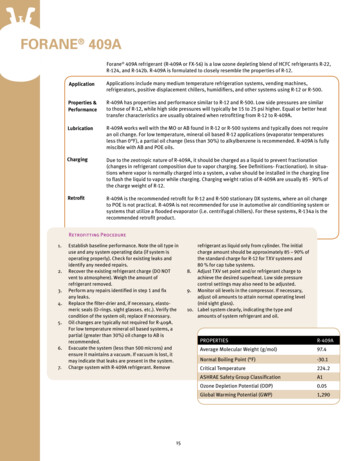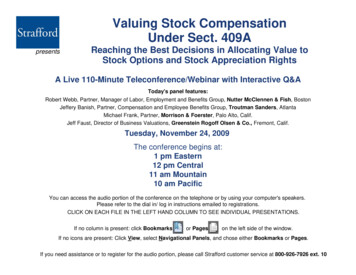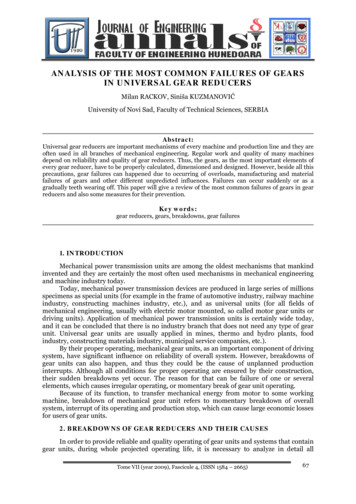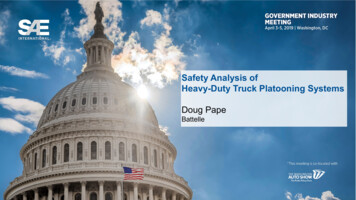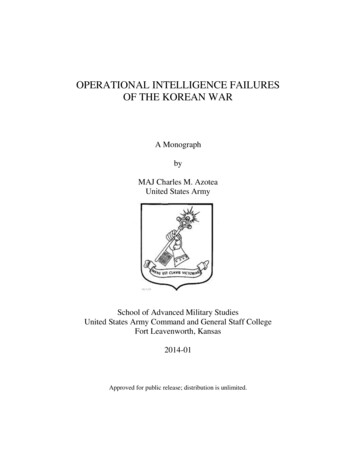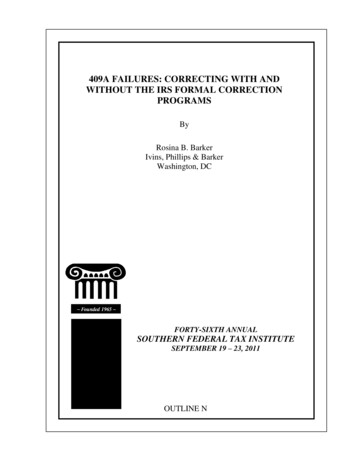
Transcription
409A FAILURES: CORRECTING WITH ANDWITHOUT THE IRS FORMAL CORRECTIONPROGRAMSByRosina B. BarkerIvins, Phillips & BarkerWashington, DCFORTY-SIXTH ANNUALSOUTHERN FEDERAL TAX INSTITUTESEPTEMBER 19 – 23, 2011OUTLINE N
Rosina B. BarkerRosina B. Barker is a partner with Ivins, Phillips & Barker, Washington, D.C. She devotes herpractice to executive compensation, employee benefits and qualified plans. Before joining Ivins, sheserved on the staff of the Ways and Means Committee, U.S. House of Representatives, where she hadprimary staff responsibility for benefits-related tax provisions in all legislation from the Tax Reform Actof 1986 through the Omnibus Reconciliation Act of 1990.She received her J.D magna cum laude, Georgetown University Law Center, M.P.P., HarvardKennedy School of Government, and A.B. cum laude, Harvard University.Rosina is a Fellow, American College of Employee Benefits Counsel, and a Member of the BNAPension & Benefits Advisory Board. She served as Chair of the D.C. Bar, Employee Benefits Committee,Taxation Section, 2003 – 2006 and Co-editor in Chief, Benefits Law Journal, 1997 – 2001.She is a contributing author of The 409A Handbook (BNA 2010) and Cash Balance Plans (Aspen2003)Recent publications (with Kevin O'Brien) include Taxing Clawbacks: Theory and Practice, TaxNotes, October 25, 2010; Document Failures in the 409A-Covered Plan: Correcting with and withoutNotice 2010-6, BNA Pension and Benefits Daily, April 12, 2010; 409A Failures: Correcting With andWithout Notice 2008-113, Tax Notes, August 10, 2009; Vesting Deferred Compensation Under 409A:When Words are More Taxing than Deeds, Tax Notes February 6, 2006; Cash Balance Plans and AgeDiscrimination: The Statute Speaks and Most Courts Listen, Benefits Laws Journal, Spring 2005; CodeSection 409A and the Hidden Deferred Compensation in Executive Employment Agreements, BenefitsLaw Journal, Winter 2005; Limiting 401(k) Fiduciary Exposure After Enron: Put Your Prose to Work,Benefits Law Journal, Autumn 2004; Discharging Deferred Compensation Obligations Upon Sale of aBusiness, Benefits Law Journal, Spring 2003; Double Indemnity: Does Your Plan's FiduciaryIndemnification Clause Protect Your Plan Administrator? Benefits Law Journal, Autumn 2002; Guilt ByAssociation: The ERISA Fiduciary Status of Principals, Agents, Officers, Directors and Other Affiliates,Benefits Law Journal, Summer 2002.N
409A FAILURES: CORRECTING WITH AND WITHOUTTHE IRS FORMAL CORRECTION PROGRAMSByRosina B. BarkerIvins, Phillips & BarkerWashington, DCrbarker@ipbtax.comI.INTRODUCTION . N-1A. What Section 409A Does . N-1B. Penalties for Noncompliance . N-1II. CORRECTING OPERATIONAL FAILURES . N-2A. Correcting Operational Failures with the IRS Correction Program under Notice 2008113 . N-2B. Correcting Failures of Nonvested Compensation Under Proposed 409A IncomeInclusion Regulation . N-6III. CORRECTING OPERATIONAL FAILURES UNDER GENERAL INCOMEPRINCIPLES . N-7A.B.C.D.E.F.G.IRS View of Section 409A . N-7Better View of Section 409A . N-7Correcting Mistaken Payments Under the Couch-Russel Rule . N-7Correcting Mistaken Payments as a Rescission . N-9Later-Year Corrections of Mistaken Payments . N-11Correcting Erroneous Deferrals . N-12Correcting Stock Option Failures . N-13IV. CORRECTING DOCUMENT FAILURES . N-15A.B.C.D.E.F.Section 409A Document Requirements . N-15Unanswered Questions . N-15Correcting Document Failures for Nonvested Deferred Compensation . N-16Formal Corrections Under Notice 2010-6 . N-17Corrections Permitted by Notice 2010-6 Outside the Formal Program . N-24Scrivener's Error and Traditional Doctrines of Contract Interpretation . N-26N-i
N-ii
409A FAILURES: CORRECTING WITH AND WITHOUTTHE IRS FORMAL CORRECTION PROGRAMSByRosina B. BarkerIvins, Phillips & BarkerWashington, DCrbarker@ipbtax.comI.INTRODUCTIONA. What Section 409A Does1. General RuleSection 409A restricts the design and operation of nonqualified deferredcompensation plans, generally as follows:(1)Initial deferral elections and subsequent deferral elections can be made only atspecified times, subject to strict rules.(2)Payments are permitted only on a specified date, or according to a specifiedschedule, or on the occurrence of a permitted payment trigger (separation from service,death, disability, certain changes in control, and unforeseeable emergencies).(3)Payment to a ―specified employee‖ (generally 50 top-paid officers of a publiclyheld company) upon separation from service is not permitted until 6 months after thedate of separation.(4)The plan must be in writing, and the plan document must specify certainrequired elements of the plan.2. Short Term DeferralsUnder regulations, a ―short term deferral‖ is not subject to the rules of § 409A.Generally, a short term deferral is a promise not paid or payable later than 2 ½ months after the end ofthe vesting year. Treas. Reg. § 1.409A-1(b)(4).Example. In December 2012, A is entitled to a bonus payable on June 31, 2013, butonly if A is still employed on the June 30, 2013 payment date. Accordingly, A’s bonusis subject to a substantial risk of forfeiture (not vested) until June 30, 2013. Becausepayable before 2 ½ months after the 2013 vesting year, the bonus is a short term deferraland not subject to § 409A.B. Penalties for Noncompliance1. Tax and PenaltiesIf a plan fails either the operational or document requirements of § 409A, anyaffected employee1 is subject to income tax and 20% penalty on all vested amounts deferred under theplan as of the last day of the employee’s taxable year of failure, plus a so-called ―premium interest tax‖(tax equal to federal underpayment rate plus 1 percentage point) on failed compensation since the vestingdate. IRC 409A(a)(1); Prop. Treas. Reg. § 1.409A-4(a)(2)(i), 73 Fed. Reg. 74,380, 73,394.2. Employer’s Withholding ObligationThe employer is subject to withholding taxes on vested deferred compensationincluded in income because of a 409A failure. If the amount is not constructively or actually receivedthe amount is deemed to be included in income on December 31 of the employee’s taxable year of1Section 409A applies to independent contractors as well as employees, and regulations use the terms ―serviceprovider‖ and ―service recipient.‖ For simplicity, this outline instead uses the terms ―employee‖ and ―employer.‖N-1
failure. Withholding taxes do not apply to the 20% penalty tax or premium interest tax, which are solelythe obligation of affected employees. IRC § 3401(a); Notice 2008-115, 2008-52 IRB 1367.3. Effect of Plan Aggregation RuleIn the case of an operational failure, the plan subject to tax and penalties is not onlythe arrangement under which the failure occurrs, but all arrangements that are part of the same ―plan‖ asdefined under the 409A aggregation rule of the regulations, covering the same employee. Treas. Reg. §1.409A-1(c)(2)(C).Example: A parachute payment of 100,000 is paid to Executive A, who is a specifiedemployee (one of top-50 officers of publicly held company) immediately upon hertermination, in violation of the 6-month rule. Executive A is also vested in asupplemental executive retirement plan (SERP), with payments due to commence in 5years when she attains age 60. Assume both arrangements are the same ―plan‖ under the409A aggregation rule. The present value of the Executive A’s future SERP payments(discounted to the earliest permitted payment date) is 4 million. Prop. Treas. Reg. §1.409A-4(b)(2)(i). The failure in the parachute payment triggers tax and penalties onboth the 100,00 parachute payment and the 4 million present value of the vestedfuture SERP payments—even though no 409A failure occurred as to any SERP benefit.The employer is subject to income withholding taxes on 4.1 million of vested deferredcompensation.Executive A is subject to income taxes (less withholding taxes), plus 20% of 4.1million, plus a premium interest tax equal the federal underpayment rate plus 1%, on allfailed compensation since its vesting date. If the failure is caught on audit, of course,actual interest would apply, along with potential penalties attributable to theunderstatement of income.Under regulations, Executive A is permitted to take a distribution of amounts included inincome because of the 409A failure. Treas. Reg. § 1.409A-3(j)(4)(vii).II.CORRECTING OPERATIONAL FAILURESA. Correcting Operational Failures with the IRS Correction Program under Notice2008-1131. GenerallyNotice 2008-113, 2008-51 I.R.B. 1305, sets forth the IRS's program for correctinginadvertent operational (but not documentary) failures with reduced penalties. An employer correctingfailures under 2008-113 will reduce penalties to zero in some cases, or a reduced penalty amount inothers. The advantage of Notice 2008-113, even for the highest penalty amount under the Notice, istwofold. First, the penalty applies only to the failed amount, and not to all deferrals under the sameaggregated plan. Second, the 20% penalty applies, but the premium interest tax does not.2. Notice 2008-113 is Available Only For Certain Types of FailureNotice 2008-113 is available only for certain types of failures described in theNotice, and then only for failures corrected in the taxable year of the failure, or (for certain failures) notlater than the end of the second taxable year after the failure year.Note: For corrections under Notice 2008-113, the relevant year is the employee’staxable year, which is assumed here to be the calendar year.a. Erroneous PaymentsErroneous payments arise when deferred compensation is paid or made availablein a taxable year before the taxable year in which payment was due. Erroneous payments include bothmistaken payouts and mistaken failures to honor the employee's deferral election.Example. Employee A elects to defer his 200 bonus, due April 1, 2012, untilseparation from service. By mistake, only 100 is deferred, and 100 is paid to himcurrently on April 1,2012. Under Notice 2008-113, the 100 current payment incontravention of A’s deferral election is an erroneous payment.N-2
b. Erroneous Payments in Violation of 6-month or 30-day ruleSix-month/30-day failures are a special kind of erroneous payment arising ineither of two circumstances. A 30-day failure occurs if the payment is made in the right tax year butmore than 30 days before the stated payout date. A six-month failure occurs if payment is made to aspecified employee in violation of the six-month rule.c. Erroneous DeferralsErroneous deferrals arise when compensation payable to the employee in the taxyear is not paid and is instead ―erroneously credited‖ to his deferred compensation account or ―otherwisetreated as deferred compensation under the plan.‖ One kind of erroneous deferral arises whencompensation is mistakenly deferred, by election or otherwise. Another kind occurs when paymentshould have been made on a specified payout date or trigger but is not.Example 1: Employee A has elected to defer 100 out of his 200 bonus otherwisepayable on June 1, 2012, and to be paid the other 100 currently on June 1. By mistake,the payroll department credits the entire 200 to his deferred compensation account, andfails to pay him the 100 he has chosen to receive currently. The failure to pay the 100currently is an erroneous deferral.Example 2: Employee B elects to defer her 200 bonus until 2015. If the amount ismistakenly paid a year too late, in 2016, an erroneous deferral has arisen.Notice 2008-113 is available to correct both kinds of erroneous deferrals.Notice 2010-6, § XIII(B), 2010-3 I.R.B. 275.d. Stock Option and Stock Appreciation Right FailuresA stock option and stock appreciation right (SAR) failure occurs when an optionor SAR is erroneously granted with an exercise price that is less than the fair market value of theunderlying stock on the date of the grant. No other kind of stock option or SAR failure is correctibleunder the Notice.3. Corrections Get More Expensive For Older Corrections and “Insiders”While available only for very specifically defined failures, the Notice sortscorrections by the employee’s taxable year of correction, rather than type of failure. The Notice alsomakes correction in any year more expensive for ―insiders‖ than for non-insider employees. Insiders aredefined by the Notice as officers, directors, and certain beneficial owners of 10% or more of thecompanies stock, determined under SEC rules except without regard to whether the company is publiclytraded.(1)Failures corrected in the failure year. Failures may be corrected in the taxableyear in which the failure arose under section IV of the Notice, without 409A tax orpenalty. Erroneous payments are generally corrected by the employee’s repayment ofthe payment to the employer. If repayment would involve a financial hardship to theemployee, repayment may be made over a 24-month period. If the employee is aninsider, the hardship schedule is not available, and repayment to the employer mustinclude interest. Deferral failures are corrected by adjusting the account balance(including earnings for an insider), and paying the incorrectly non-paid amount to theemployee. A failure in the strike price of a stock option or SAR may be corrected byresetting the strike price, but only if the option or SAR has not been exercised. No 409Atax or penalty is owed for failures corrected under section IV in the failure year.(2)Failures corrected in the year after the failure year by a non-insider. Failuresmay be corrected in the year after the failure year under section V, also without 409Atax and penalty, but only for a non-insider. Penalty-free corrections under section V arenot available for insiders. Permitted corrections are generally the same as same-yearcorrections under section IV, with some adjustments. Erroneous payments must berepaid with interest. As with same year corrections under Section IV, failures in thestrike price of stock options and SARs may be reset, provided the option or SAR has notN-3
been exercised. As with same-year corrections under Section IV of the Notice, affectedemployees pay no 409A tax or penalties.(3)Failures involving a ―limited amount‖ corrected within two years following thefailure year. Section VI of the Notice provides that failures of less than the § 402(g)limit ( 16,500 in 2011) not eligible under (1) or (2) may be corrected with reducedpenalty. Erroneous payments must be repaid with interest; erroneous deferrals must bereturned by the employer, with no adjustment for the time value of money cost to theemployee, and any earnings in the deferred compensation account deleted. ―Limitedamount‖ corrections under Section VI are not available for stock option and SAR strikeprice failures. The failed amount is includible in income under 409A and subject to the20% penalty, but not the premium interest tax. Only the failed amount is subject to409A tax and 20% penalty; remaining amounts in the failed plan are not subject to 409Atax or penalty. These ―limited amount‖ corrections under Section VI may be made anytime before the end of the second year following the failure year.(4)Other failures corrected within two years after the failure year. Regardless ofamount, Section VII provides for correction of certain failures corrected within twoyears after the failure year, at reduced penalty. Erroneous payments must be repaid bythe employee to the employer, with interest if by an insider. Erroneous deferrals must berepaid to the employee, with no adjustments for time value of money. The failedamount is includible in income under 409A and subject to the 20% penalty, but not thepremium interest tax. Only the failed amount is subject to 409A tax and 20% penalty;remaining deferrals in the failed plan are not subject to 409A tax or penalty. Correctionunder section VII is not available to correct failures in the strike price of a stock optionor SAR. Correction under Section VII is not available for failure to observe the sixmonth rule, if payment should have been made in a later taxable year than the year of theerroneous payment.Example 1 – Erroneous payment to a Non-Insider. Employee A, who is not an insider,is due to be paid a 200,000 bonus on June 1, 2012, and has properly elected to defer theentire amount under the employer’s deferred compensation plan. By mistake, thepayroll department defers only half of it ( 100,000) and pays the other 100,000currently to Employee A on June 1, 2012.(a) Correction in failure year. The failure is detected in 2012, the failure year.Correction is accordingly made under Section IV of Notice 2008-113. Employee Arepays the bonus to the employer by December 31, 2012. If A repays by having theamounts withheld from other earnings payable during the year, the withheld amounts areincluded in A’s income and wages reported on A’s W-2 for 2012. The employer ispermitted to credit earnings to A’s deferred compensation account to make-up for theearnings that would have accrued had additional 100,000 been properly deferred.Employee A pays no 409A tax or penalty on any amount. The employer files thestatement required with the IRS on its 2012 tax return and takes other corrective actionrequired by the Notice. Because the failure is corrected in the failure year, Employee Ais not required to attach a statement to her own tax return. See Section II.A.4 of thisOutline.(b) Correction in second year after failure year. Change the example so thefailure is detected in 2014, two years after the failure year. Correction is accordinglymade under Section VII of Notice 2008-113. Employee A repays the bonus to theemployer as above, and the employer is permitted to credit earnings to A’s deferredcompensation account to make up for the earnings that would have accrued had the 100,000 been properly deferred. A files an amended return for 2012, showing the 100,000 erroneous payment in Box 12, Code z and pays a tax of 20% on the 100,000failure amount. Employee A does not pay the additional premium interest tax, and theadditional amounts deferred under the plan are not subject to 409A tax or penalty. Theemployer and Employee A both file statements on their tax returns filed for 2013, thecorrection year, describing the correction. See Section II.A.4. of this Outline.Example 2 – Erroneous payment to an Insider. Change the example so that Employee Ais an ―insider.‖ As before, correction is made under Section IV of the Notice if made inthe failure year or Section VII of the Notice if made by the end of the second yearN-4
following the failure. The correction is generally the same as under Example 1, exceptthat, as an Insider, Employee A must repay not only the erroneous payment, but also―interest‖ to the employer at the short term AFR in the month of the overpayment.4. IRS Requirements Must Be MetNo correction under Notice 2008-113 is effective unless the employer (andemployee) meet numerous specific requirements detailed in the Notice. See Notice 2008-113, § III.(1)The employer must attach to its own tax return filed for any correction astatement entitled ―409A Relief‖ showing the name and TIN of each affected employee,name of plan and description of failure, amount involved, specific correction, etc.(2)The employer must provide each affected employee with detailed informationabout the failure and correction, no later than the deadline for providing W-2s to theemployee.(3)The employee must attach the statement supplied by the employer to his or herown tax return filed for the correction year. Notice 2008-113, § IX.(4)For same-year corrections under Section IV, a special rule provides that theemployee is not required to file any correction statements with his or her own tax returnfor the correction year, and the employer is not required to supply the employee with anotice of the correction. The employer, however, is still required to provide a statementof the correction to the IRS appended to the employer’s tax return for the failure year,including the TINs of affected employees. Notice 2008-113 § IX(A), as modified byI.R.S. Notice 2010-80, 2010-51 I.R.B. 853, § III(H).(5)If the failure is a mistaken payment, the employee must repay the mistakenpayout to the employer and, in some instances, an additional amount to the employercharacterized by Notice 2008-113 as ―interest.‖ The amount to be repaid equals thegross amount, before withholding taxes (except to the extent that the service recipienthas recouped withholding taxes, for example by filing Form 941-X). Notice 2010-6, §XIII(A), 2010-3 I.R.B. 275. For mistaken payments of property, generally the amountreturned must be the fair market value of the property on the date of the mistakenpayment. Notice 2008-113, § III(E).(6)Correction of a mistaken payment is not available if the employer ―pays‖ or―otherwise provides a benefit (including an obligation to pay an amount or provide abenefit in the future), intended as a substitute for all or part of the amount‖ of theemployee's required repayment of the mistaken payout or purported interest. Notice2008-113, § III(E). Notice 2010-6 clarifies that a prohibited benefit includes a loan fromthe employer to the employee. Notice 2010-6, § III(A). It is unclear whether thisincludes a gross-up by the employer for any 409A taxes paid by affected employees.The author believes the better answer is ―no.‖ The prohibited benefit rule ensures anemployee is not made better off by a mistaken payment. A gross-up does not make theemployee better off; it merely restores the employee to the economic position he or shewould have enjoyed absent the mistaken payment.(7)Correction is not available for a mistaken payment made in the employee's taxyear in which the employer has a ―substantial financial downturn, or otherwiseexperiences financial or other issues, if [the] downturn or other issue indicates asignificant risk‖ that the employer will not be able to pay the amount deferred when due.Notice 2008-113, § III(F).(8)The Employer must take ―commercially reasonable steps‖ to prevent the failurefrom occurring again. If the same or a ―substantially similar‖ failure has happenedbefore, the employer (or employee) must show that the employer established ―practicesand procedures reasonably designed‖ to avoid a similar mistake, that the employer hadtaken ―commercially reasonable steps‖ to avoid the failure, and that the failurereoccurred despite those ―diligent efforts.‖ Notice 2008-113, § III(B). Correction is notavailable for any failure occurring in a taxable year if the employee's tax return for thatyear is under audit. Notice 2008-113, § III(C).N-5
Failure to satisfy any of these requirements may mean that correction under Notice2008-113 is unavailable.5. Limitations of Notice 2008-113 as Correction Tool(1)Notice 2008-113 is not available for failures not specified in the Notice, or tocorrect any operational failure more than two years old.(2)For failures in options and SARs, it is even more limited. Notice 2008-113 isavailable to correct only a failure to set the strike price at the fair value of the stock onthe grant date, and is completely unavailable after the option or SAR has been exercised.Other potential failures — e.g., the underlying stock has a lapse restriction in violationof the permitted definition of ―service recipient stock‖ for this purpose — may not becorrected under Notice 2008-113 or under Notice 2010-6 (relating to correction ofdocument failures, see Section IV.D of this Outline).(3)A correction is always vulnerable to being disallowed on audit if the examinerconcludes that correction fails to meet any of the Notice’s exacting requirements.(4)Correction requires detailed reporting by both employer and (except for sameyear corrections) the employee on their respective tax returns filed for the correctionyear.B. Correcting Failures of Nonvested Compensation Under Proposed 409A IncomeInclusion RegulationLimited correction of operational failures involving nonvested compensation ispermitted by the proposed § 409A income inclusion regulations. Prop. Treas. Reg. § 1.409A-4, 73 Fed.Reg. 74,380 (Dec. 8, 2008). An operational failure can be corrected to the extent of compensation that isnonvested in the correction year. The proposed regulation includes an anti-abuse rule to preventexcessive manipulation of the time and form of payment of nonvested deferred compensation.1. Limitations of Proposed 409A Income Inclusion Regulation as Correction Tool(1)Even if operational failure affects only nonvested compensation , a ―taint‖ ruleprovides that any vested deferred compensation under the same plan, as defined by the409A aggregation rule of the regulations, is subject to 409A tax and penalties. Prop.Treas. Reg. § 1.409A-4(a)(1)(i); see also Preamble to Prop. Treas. Reg. § 1.409A-4, 73Fed. Reg. 74,380.(The ―taint‖ rule does not apply for correction of document failures. See Section IVA ofthis Outline.)Example: Executive A is covered by a vested SERP benefit with a PV of 4 million,and a nonvested parachute benefit of 100,000 (nonvested because the change in controlhasn’t occurred yet). The parachute plan and the SERP are both in the same aggregatenon-account balance (defined-benefit type) plan under regulations. A mistaken paymentis made under the 100,000 parachute benefit. The failure in the parachute benefit iscorrected before the change in control occurs, and thus before the compensation vests.The nonvested parachute benefit is not subject to tax or penalties, but the vested SERP issubject to 409A tax and penalties on the 4 million discounted present value of futurebenefits. To avoid this aggregation, it would be necessary to submit the parachutefailure to the IRS through the Notice 2008-113 program.(2)Second, it is not entirely clear if the correction can be made only ifcompensation is still nonvested on the last day of the taxable year, or whether, in thealternative, correction is possible any time before the compensation vests. IRSspokespersons seem to think it applies only if the compensation is nonvested all year.The author believes that the better technical reading of the proposed regulation is that thecorrection is effective if made any time before the compensation vests, even if thecompensation vests later in the correction year. The IRS will presumably clarify whenfinal regulations are promulgated.N-6
NERALINCOMEA. IRS View of Section 409AThe IRS appears to view Section 409A as a strict-liability statute. A failure in a plandocument or operation automatically triggers tax and penalties. Accordingly any inadvertent payment ornonpayment is a failure because it cannot be unwound under income doctrines of longer standing.B. Better View of Section 409AThe legislative history of § 409A shows that Congress thought it was not creating newincome doctrines, but rationalizing old ones, in particular the doctrine of constructive receipt. See H.R.Rep. No. 108-548, pt. I, at 341 (2004), available at 2004 WL 1380512 (report on the American JobsCreation Act of 2004, Pub. L. No. 108-357, 118 Stat. 1418).Underlying the theories of actual and constructive receipt is the principle of mutualassent to income receipt—the principle that income is not received unless its receipt is mutually agreedon by the obligor and the obligee, at the time fixed by their mutual agreement. For example, the TaxCourt recognized in Millsaps v. Commissioner, T.C. Memo. 1973-146, 32 T.C.M. (CCH) 694, that thereis no constructive receipt of deferred compensation when the payer unilaterally offers to pay before theagreed due date and the payee neither solicited the offer nor accepted it. The IRS acquiesced in Millsaps,noting that the payee-taxpayer neither initiated the acceleration nor agreed to the offer. See 1973 WL35028 (Sept. 5, 1973). A second fundamental doctrine is the primacy of annual income accounting. Thelegislative history and statutory language of § 409A shows that Congress intended these principles tosurvive into the definition of income subject to § 409A. In sum, the correction doctrines discussed belowin Section IV. of this outline are part and parcel of the underlying idea that income receipt is based onmutual assent, and also on the primacy of the principle of annual income accounting. Because theseunderlying principles survives into § 409A, the related correction doctrines should survive as well. For afull discussion of these
She is a contributing author of The 409A Handbook (BNA 2010) and Cash Balance Plans (Aspen 2003) Recent publications (with Kevin O'Brien) include Taxing Clawbacks: Theory and Practice, Tax Notes, October 25, 2010; Document Failures in the 409A-Covered Plan: Correcting with and without

